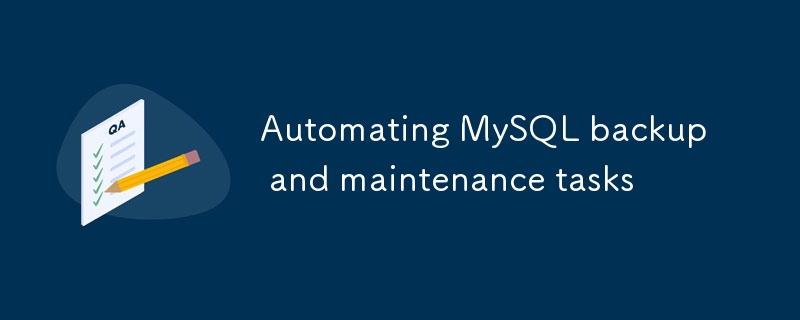Automating MySQL backup and maintenance tasks
Jul 05, 2025 am 02:39 AMTo realize automatic backup and maintenance of MySQL database, you can use the following methods: 1. Use the mysqldump command to achieve daily automatic backup with shell scripts and crontab timing tasks, and it is recommended to compress files, select non-system disk path storage, and regularly clean old backups; 2. Set up backup retention strategies, such as keeping daily backups within 7 days and weekly backups within month and weekly backups, and delete expired files through the find command, confirm that the backup has been uploaded before cleaning and avoid accidentally deleting other environmental data; 3. Use the MySQL event scheduler or external script to perform maintenance tasks such as optimization tables and analysis tables regularly, pay attention to avoiding business peaks and avoiding frequent optimization of large tables. These methods can effectively improve data security and system stability, and reduce manual operation errors and repetitive work.

Backup and daily maintenance of MySQL databases are key steps to ensure data security and system stability. Manual operation is not only time-consuming, but also prone to errors. Therefore, it is very necessary to automate these tasks. Below are some practical methods and suggestions to help you easily implement automatic backup and maintenance of MySQL.

Use mysqldump to achieve automatic backup
This is the most common and easiest way. The mysqldump command can be used to export the database as a SQL file, which is easy to restore or migrate.

You can write a simple shell script, such as:
#!/bin/bash DATE=$(date "%Y%m%d") BACKUP_DIR="/backup/mysql" DB_USER="root" DB_PASS="yourpassword" mysqldump -u $DB_USER -p$DB_PASS --all-databases > $BACKUP_DIR/db_backup_$DATE.sql
Then set crontab to execute this script regularly:

0 2 * * * /path/to/backup_script.sh
This way, a backup will be automatically generated at 2 a.m. every day.
Tips:
- Compressing the backup file can save space, such as adding
gzip. - It is best not to have the backup path on the system disk to avoid the full disk affecting the service.
- Remember to clean old backups regularly, otherwise a lot of useless files will accumulate over time.
Setting up retention policies and cleaning mechanisms
It is not enough to do a good backup, but you have to manage it well. If you don't clean up old backups, the hard drive will be filled sooner or later.
Common practices are:
- Keep a backup of the last 7 days a day
- Keep weekly backups for one month per week
- Or use naming rules to distinguish (e.g. with date suffix)
An additional script can be used to delete expired files, such as:
find /backup/mysql -type f -name "*.sql" -mtime 7 -exec rm {} \; This command will delete .sql files that have been over 7 days.
Notice:
- It is best to confirm whether the backup has been uploaded to the remote server or cloud storage before cleaning.
- If you are deploying multiple instances, remember to process them separately by instance and do not delete data from other environments by mistake.
Use MySQL's own event scheduler for daily maintenance
In addition to backup, maintenance tasks such as table optimization and log cleaning can also be automated.
MySQL provides the Event Scheduler function, which can execute SQL commands regularly within the database.
For example, you can create an event to regularly optimize a table that is updated frequently:
CREATE EVENT optimize_tables ON SCHEDULE EVERY 1 WEEK STARTS '2025-04-06 03:00:00' DO OPTIMIZE TABLE your_database.your_table;
Of course, you can also write a script to call multiple OPTIMIZE TABLE or ANALYZE TABLE commands, and then execute them through crontab.
hint:
- Do not optimize large tables frequently, as they will affect performance.
- Try to avoid peak business hours when maintenance is done.
- It is best to do a check before optimization to see which tables really need to be optimized.
Basically that's it. Automating backup and maintenance of MySQL is not complicated, but it is very practical. As long as you configure scripts and timing tasks, you can save a lot of repetitive work and help you quickly recover data at critical moments.
The above is the detailed content of Automating MySQL backup and maintenance tasks. For more information, please follow other related articles on the PHP Chinese website!

Hot AI Tools

Undress AI Tool
Undress images for free

Undresser.AI Undress
AI-powered app for creating realistic nude photos

AI Clothes Remover
Online AI tool for removing clothes from photos.

Clothoff.io
AI clothes remover

Video Face Swap
Swap faces in any video effortlessly with our completely free AI face swap tool!

Hot Article

Hot Tools

Notepad++7.3.1
Easy-to-use and free code editor

SublimeText3 Chinese version
Chinese version, very easy to use

Zend Studio 13.0.1
Powerful PHP integrated development environment

Dreamweaver CS6
Visual web development tools

SublimeText3 Mac version
God-level code editing software (SublimeText3)

Hot Topics
 How to backup and restore database after mysql installation
Apr 08, 2025 am 11:45 AM
How to backup and restore database after mysql installation
Apr 08, 2025 am 11:45 AM
There is no absolutely optimal MySQL database backup and recovery solution, and it needs to be selected based on the amount of data, business importance, RTO and RPO. 1. Logical backup (mysqldump) is simple and easy to use, suitable for small databases, but slow and huge files; 2. Physical backup (xtrabackup) is fast, suitable for large databases, but is more complicated to use. The backup strategy needs to consider the backup frequency (RPO decision), backup method (data quantity and time requirement decision) and storage location (off-site storage is more secure), and regularly test the backup and recovery process to avoid backup file corruption, permission problems, insufficient storage space, network interruption and untested issues, and ensure data security.
 How to use MySQL data backup and recovery tools for disaster recovery
Aug 02, 2023 am 09:06 AM
How to use MySQL data backup and recovery tools for disaster recovery
Aug 02, 2023 am 09:06 AM
How to use MySQL data backup and recovery tools to achieve disaster recovery. Data backup and recovery are a very important part of the database management process. Backing up your data protects your database from accidental corruption, hardware failure, or other catastrophic events. As a popular relational database management system, MySQL provides some powerful tools to achieve data backup and recovery. This article will introduce how to use MySQL's data backup and recovery tools to achieve disaster recovery. MySQL data backup tool-mysql
 How do you back up and restore a MySQL database?
Apr 28, 2025 am 12:23 AM
How do you back up and restore a MySQL database?
Apr 28, 2025 am 12:23 AM
Using mysqldump for logical backup and MySQLEnterpriseBackup for hot backup are effective ways to back up MySQL databases. 1. Use mysqldump to back up the database: mysqldump-uroot-pmydatabase>mydatabase_backup.sql. 2. Use MySQLEnterpriseBackup for hot backup: mysqlbackup--user=root-password=password--backup-dir=/path/to/backupbackup. When recovering, use the corresponding life
 How to effectively manage and maintain ibd files in MySQL database
Mar 16, 2024 am 11:21 AM
How to effectively manage and maintain ibd files in MySQL database
Mar 16, 2024 am 11:21 AM
In the MySQL database, each InnoDB table corresponds to an .ibd file, which stores the table's data and indexes. Therefore, for the management and maintenance of MySQL database, the management of ibd files is also particularly important. This article will introduce how to effectively manage and maintain ibd files in a MySQL database and provide specific code examples. 1. Check and optimize table space First, we can check the disk space usage of the table using the following SQL statement: SELECTTAB
 Multiple backup solutions for MySql: How to efficiently create and restore MySQL backups
Jun 15, 2023 pm 03:28 PM
Multiple backup solutions for MySql: How to efficiently create and restore MySQL backups
Jun 15, 2023 pm 03:28 PM
MySql is a commonly used relational database management system that is widely used in various business and application scenarios. For MySQL backup issues, the selection and execution method of the backup plan are crucial. In this article, we will introduce various backup options and how to create and restore MySQL backups efficiently. 1. Selection of backup plan In the process of selecting a MySQL backup plan, you should choose a backup plan that suits you based on the business scenario and actual situation. Cold backup The so-called cold backup is to complete the MySQL database.
 MySql database backup: How to achieve efficient MySQL database backup and recovery
Jun 15, 2023 pm 11:37 PM
MySql database backup: How to achieve efficient MySQL database backup and recovery
Jun 15, 2023 pm 11:37 PM
MySQL is one of the most widely used relational database management systems currently. Its efficiency and reliability make it the first choice for many enterprises and developers. But for various reasons, we need to back up the MySQL database. Backing up a MySQL database is not an easy task because once the backup fails, important data may be lost. Therefore, in order to ensure data integrity and recoverability, some measures must be taken to achieve efficient MySQL database backup and recovery. This article will introduce how to achieve
 MySQL rolling backup techniques for data
Jun 15, 2023 pm 07:47 PM
MySQL rolling backup techniques for data
Jun 15, 2023 pm 07:47 PM
MySQL is a popular relational database that is widely used in various fields. However, like other applications, MySQL has risks such as data corruption, crashes, and malicious attacks. Therefore, backing up your data is crucial. Backups can provide security and some form of "undo" functionality to data, reducing or even eliminating instability and risk. The most common backup types are full backup and incremental backup. However, if you need frequent, real-time backups, rolling backups are a better approach. A rolling backup is when an acceptable
 A comprehensive guide to MySQL backup and recovery
Jun 15, 2023 am 09:48 AM
A comprehensive guide to MySQL backup and recovery
Jun 15, 2023 am 09:48 AM
MySQL is currently one of the most popular relational database management systems and is widely used in enterprise-level applications. Whether you are a developer or a data administrator, you need to understand the basic knowledge of MySQL backup and recovery. Backup and recovery not only help enterprises protect data, but also enable systems to respond quickly to adverse situations and restore them to normal operating conditions as much as possible. This article will detail the steps for MySQL backup and recovery and provide some best practices to help readers go further in protecting their MySQL databases.






